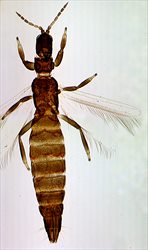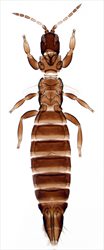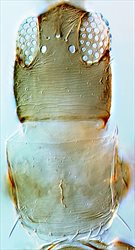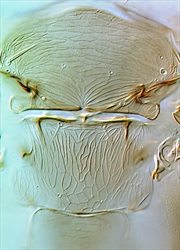
Female macroptera

Short-winged female

Head & pronotum

Antenna

Meso & metanota of macroptera

Meso & metanota of microptera

Fore wing
Both sexes fully winged or micropterous. Body, legs and antennae largely brown, tarsi yellow, also apex of tibiae and base of mid and hind femora; antennal segments I–II brown, III almost yellow; fore wing pale with posterior margin weakly shaded. Antennae 9-segmented, VII–IX forming a unit, segments III–IV with sensorium transverse at apex. Head longer than wide, with less than 5 pairs of small ante-ocellar setae; inter-ocellar setae prominent, arising on anterior margin of ocellar triangle. Pronotum with 1 pair of long posteroangular setae, 2 (or 3) pairs of posteromarginals. Metanotum with elongate reticulation in macropterae, but irregular sculpture in micropterae, without microtrichia, median setae near posterior margin. Fore tarsus with strongly recurved hamus. Fore wing with cross veins visible. Abdominal tergites with transverse reticulation, trichobothria on X about as large as major setal bases. Sternites III–VI with 2 or 3 pairs of posteromarginal setae, lateral pairs arise submarginally; sternite VII with 4 pairs of posteromarginal setae, also 2 pairs of accessory setae, but no discal setae laterally.
Male tergite I with paired longitudinal ridges scarcely one third as long as tergite.
Six species are recognised in the genus Rhipidothrips, although only brunneus and gratiosus are widespread in Europe. Two species are known only from south-eastern Europe, one from the Canary Islands, and one is recorded from Finland and France (zur Strassen, 2003). The two Rhipidothrips species found in Britain are distinguished by the colour of antennal segment II and the number of posteromarginal setae on the pronotum.
Presumably phytophagous on Poaceae, and often on plants growing in damp places; in Britain recorded from Bromus sterilis. It is mentioned by Bailey (1954) as probably predatory on other thrips in California, but there seems to be little supporting evidence.
Described from a single female from Bognor Regis, West Sussex (Williams, 1913), and otherwise only recorded from three other locations in Sussex in 1929 and 1930, and from a water trap on the Isle of Sheppey, Kent, in 2014 (Mound et al., 1976; Clemons, 2015). It is widespread across western Europe, and has also been recorded from Finland and Russia south to Egypt and Iran. It has also been found in California and Oregon, as well as in Western Australia.
AEOLOTHRIPIDAE
Rhipidothrips brunneus Williams
Rhipidothrips brunneus Williams, 1913: 216
Rhipidothrips cahirensis Priesner, 1932: 45
Bailey SF (1954) A review of the genus Rhipidothrips Uzel (Thysanoptera: Aeolothripidae). Pan–Pacific Entomologist 30: 209–220.
Clemons L (2015) Rhipidothrips brunneus Williams, 1913 (Thysanoptera: Aeolothripidae) in north Kent. Entomologist’s Record and Journal of Variation 127: 30–31.
Mound LA, Morison GD, Pitkin BR & Palmer JM (1976) Thysanoptera. Handbooks for the Identification of British Insects 1 (11): 1–79.
Williams C B (1913) Records and descriptions of British Thysanoptera. Journal of Economic Biology 8 (4): 216–230.
zur Strassen R (2003) Die terebranten Thysanopteren Europas und des Mittelmeer-Gebietes. Die Tierwelt Deutschlands 74: 1-271.